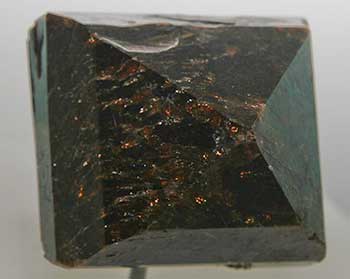 |
| Zircon - ZrSiO4. |
Zirconium
Zirconium (Zr) is a grayish-white, metallic element with an atomic number of 40. It naturally combines with silica and oxygen to form the mineral zircon (ZrSiO4), the primary ore of this element. Zircon has been known since biblical times, and it has been called by a variety of names, including jargon, hyacinth and jacinth.In the late 1700's, the German chemist Martin Heinrich Klaproth suspected that there was a new element to be found in this mineral. He reduced the mineral zircon to zirconium oxide in 1789, but never isolated the metal. In 1824, Swedish chemist, Jöns Jacob Berzelius isolated an impure zirconium metal, but it wasn't until 1914 when pure zirconium was finally produced.
Zirconium reacts with oxygen, forming a thin coating of zirconium oxide on its surface. This coating protects the metal from further oxidation. Zirconium is quite resistant to corrosion by acids and other chemicals, and is valued in industry for this resistant quality.
Zirconium has no beneficial or adverse effect on living organisms, and is resistant to corrosion. Based on these properties, it has proven to be a good material for artificial limbs and joints.
Analysis of the rocks collected on the moon has shown that zirconium is a common element on the surface of the moon.
Name
Zirconium was named after the silicate mineral in which it was first discovered, zircon. The mineral name zircon was created from the Arabic word zargun which means gold color, a reference to the color of some zircon crystals.
Sources
Zirconium is found in two minerals, zircon (zirconium silicate, ZrSiO4) and baddeleyite (zirconium oxide, ZrO2). The most important of these ores, zircon, occurs as grains concentrated in sand deposits in the southeastern United States, and in Australia and Brazil. Russia and Brazil also have large deposits of baddeleyite. World resources are estimated to be more than 60 million tons worldwide.
Fourteen million tons of zirconium are in heavy-mineral in sand deposits in the United States. The sands are called zircon sands because they contain sand-sized mineral zircon grains. Most heavy-mineral sands also have a high content of titanium-bearing minerals, such as ilmenite and rutile.
Several American metal companies in Oregon and Utah recover zirconium metal when recycling scrap metals created during metal production. Zirconium chemicals (like zirconium dioxide) are made in Alabama, New Hampshire, New York and Ohio.
In addition, zirconium ore and zirconium metal is imported. The ore is imported primarily from South Africa and Australia. Zirconium metal is imported primarily from France, Germany, Canada, and Japan.
Uses
Zirconium is used in a number of industrial applications because it is so resistant to corrosion. It is used in pumps and valves and the cores of nuclear reactors. Zirconium oxide is used to make laboratory crucibles and to line furnaces.
When zirconium is alloyed (mixed) with the element niobium, it becomes superconductive. This means that it is able to conduct electricity with very little loss of energy to electric resistance. Superconductivity is possible only at very low temperatures.
Another feature of zirconium is that it does not absorb neutrons (unlike hafnium, which absorbs neutrons, and is also found in zirconium deposits). This makes it useful in nuclear applications, where it is used as fuel cladding in nuclear reactors, and as a coating on nuclear fuel parts.
Zirconium is also used in everyday home products. Zirconium compounds are used in deodorants, flashbulbs, lamp filaments, and in artificial gemstones. Cubic zirconia is a hard, clear, gem-like material that is marketed as an inexpensive diamond-like gemstone. Colored cubic zirconia is sold as simulants of many different gemstones.
Substitutes and Alternative Sources
Different materials can be used in place of zirconium depending on the application. For example, titanium and other compounds, can be used in a few of zirconium's chemical applications. Niobium, stainless steel, and tantalum can be used in some limited nuclear applications.